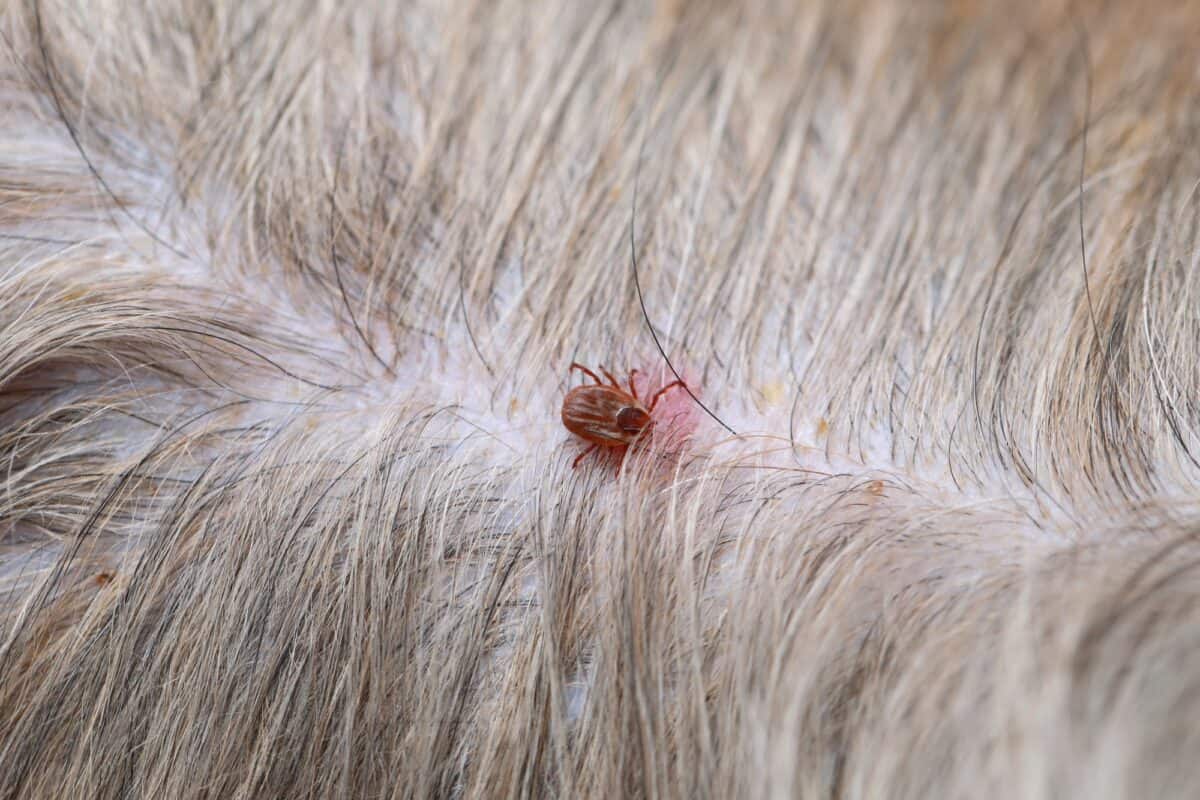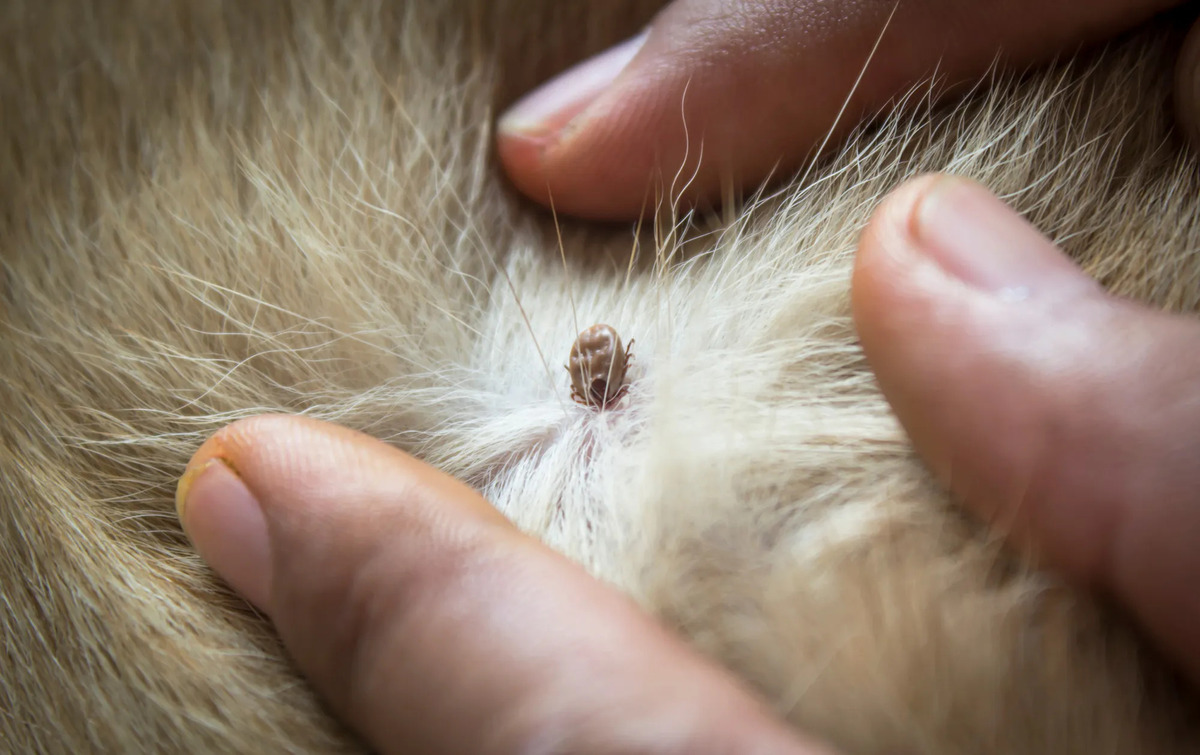Home>Health & Wellness>Common Health Issues>What Can Be Used To Keep Ticks Off Dogs


Common Health Issues
What Can Be Used To Keep Ticks Off Dogs
Modified: February 21, 2024
Protect your furry friend from common health issues by learning what can be used to keep ticks off dogs. Keep your dog healthy and happy with these preventative measures.
(Many of the links in this article redirect to a specific reviewed product. Your purchase of these products through affiliate links helps to generate commission for Pawsomeoldies.com, at no extra cost. Learn more)
Table of Contents
Introduction
Ticks are pesky parasites that can pose a threat to the health and well-being of our beloved canine companions. These tiny arachnids are not only a nuisance but can also transmit serious diseases such as Lyme disease, ehrlichiosis, and anaplasmosis. As responsible pet owners, it's crucial to take proactive measures to protect our furry friends from these blood-sucking pests.
Tick prevention is a vital aspect of maintaining the overall health of dogs. Fortunately, there are various methods and products available to help keep ticks at bay. From natural remedies to chemical repellents, there are options to suit different preferences and needs. By understanding the available choices and implementing effective preventive measures, pet owners can significantly reduce the risk of tick infestations and the associated health complications for their canine companions.
In the following sections, we will explore natural and chemical tick repellents for dogs, providing insights into their effectiveness and safety. Additionally, we will discuss essential tick prevention tips to help pet owners safeguard their dogs from these persistent parasites. By gaining a comprehensive understanding of tick prevention strategies, pet owners can make informed decisions to protect their furry friends and ensure their well-being.
As we delve into the world of tick prevention for dogs, it's important to consider the unique needs and sensitivities of our canine companions. By prioritizing their health and comfort, we can create a safe and enjoyable environment for them to thrive. Let's explore the various options available to keep ticks off dogs and empower pet owners with the knowledge to make informed choices for their furry companions' well-being.
Read more: What Keeps Fleas And Mosquitoes Off Dogs
Natural Tick Repellents for Dogs
When it comes to protecting our canine companions from ticks, natural tick repellents offer a gentle yet effective approach. These remedies harness the power of natural ingredients to deter ticks without exposing dogs to potentially harmful chemicals. Here are some natural tick repellents that can help keep these pesky parasites at bay:
1. Essential Oils
Certain essential oils have been found to possess tick-repelling properties. Oils such as cedarwood, eucalyptus, lavender, and peppermint are known for their ability to repel ticks. When diluted with a carrier oil, such as coconut oil or almond oil, these essential oils can be applied to a dog's collar or fur to help ward off ticks.
2. Apple Cider Vinegar
Apple cider vinegar is a versatile natural remedy that can be used to repel ticks. By mixing equal parts of apple cider vinegar and water in a spray bottle, pet owners can create a natural tick repellent spray. This solution can be lightly sprayed onto a dog's coat, focusing on areas where ticks are likely to hide, such as around the ears and neck.
3. Diatomaceous Earth
Diatomaceous earth is a fine powder derived from fossilized algae. It is known for its ability to dehydrate and kill ticks upon contact. When using diatomaceous earth as a tick repellent, it's important to choose a food-grade option and carefully apply a light dusting of the powder to areas where ticks are prevalent, such as bedding and outdoor resting areas.
Read more: What Gets Ticks Off A Dog
4. Herbal Flea and Tick Collars
Herbal flea and tick collars offer a natural alternative to traditional chemical-laden collars. These collars are infused with natural ingredients such as citronella, eucalyptus, and cedarwood, which can help repel ticks while emitting a pleasant scent. By opting for herbal flea and tick collars, pet owners can provide their dogs with ongoing protection against ticks without the use of harsh chemicals.
5. Neem Oil
Neem oil, derived from the neem tree, is renowned for its insect-repelling properties. When diluted with a carrier oil and applied to a dog's coat, neem oil can act as a natural tick deterrent. Additionally, neem oil can be used to create a natural tick repellent shampoo, providing dogs with a refreshing bath while helping to keep ticks at bay.
By incorporating these natural tick repellents into a comprehensive tick prevention strategy, pet owners can effectively safeguard their dogs from these persistent parasites. It's important to note that while natural tick repellents offer a gentle approach to tick prevention, it's essential to consult with a veterinarian before using any new products, especially for dogs with pre-existing health conditions or sensitivities. With the right combination of natural tick repellents and proactive preventive measures, pet owners can create a safe and tick-free environment for their canine companions to thrive.
Chemical Tick Repellents for Dogs
Chemical tick repellents offer a potent line of defense against ticks, providing effective protection for dogs in environments where tick exposure is prevalent. These products typically contain synthetic compounds that are specifically formulated to repel and kill ticks. While natural tick repellents offer a gentle approach, chemical tick repellents can be a valuable option for pet owners seeking robust tick prevention. Here are some commonly used chemical tick repellents for dogs:
1. Spot-On Treatments
Spot-on treatments are topical products applied directly to a dog's skin, usually between the shoulder blades. These treatments contain active ingredients such as fipronil, permethrin, or imidacloprid, which are designed to repel and kill ticks upon contact. Spot-on treatments provide long-lasting protection, often remaining effective for several weeks, making them a convenient option for pet owners.
2. Tick Collars
Tick collars are designed to be worn around a dog's neck and are infused with chemical compounds such as amitraz or flumethrin. These compounds are gradually released onto the dog's skin and coat, creating a protective barrier against ticks. Tick collars offer continuous protection and are particularly useful for dogs that spend time outdoors in tick-prone areas.
3. Oral Medications
Oral medications, such as chewable tablets or flavored chews, contain active ingredients that circulate in a dog's bloodstream, effectively killing ticks upon biting. These medications often contain compounds such as afoxolaner, fluralaner, or sarolaner, which disrupt the tick's nervous system, leading to their demise. Oral medications provide systemic protection and are a convenient option for pet owners who prefer not to use topical products.
4. Tick Sprays
Tick sprays are formulated to be directly applied to a dog's coat and skin, providing immediate protection against ticks. These sprays often contain pyrethroids or other synthetic compounds that repel and kill ticks on contact. Tick sprays can be particularly useful for dogs that are frequently exposed to tick-infested environments, offering an additional layer of defense against these persistent parasites.
5. Shampoos and Dips
Tick-repellent shampoos and dips contain chemical compounds that effectively eliminate ticks during bathing. These products are designed to be lathered onto a dog's coat and skin, targeting and removing ticks upon contact. Shampoos and dips can be a valuable addition to a comprehensive tick prevention regimen, especially for dogs that enjoy regular baths and require thorough tick protection.
When using chemical tick repellents, it's crucial for pet owners to carefully follow the product instructions and consult with a veterinarian to ensure the safe and appropriate use of these products. Additionally, pet owners should consider their dog's individual sensitivities and health conditions when selecting chemical tick repellents, prioritizing their pet's well-being and comfort.
By incorporating chemical tick repellents into a comprehensive tick prevention strategy, pet owners can effectively protect their dogs from tick infestations and reduce the risk of tick-borne diseases. When used responsibly and in conjunction with other preventive measures, chemical tick repellents can play a valuable role in safeguarding the health and well-being of our beloved canine companions.
Tick Prevention Tips for Dogs
Preventing tick infestations is essential for maintaining the health and well-being of dogs. By implementing proactive measures and adopting effective tick prevention strategies, pet owners can significantly reduce the risk of tick-borne diseases and ensure a safe environment for their canine companions. Here are valuable tick prevention tips for dogs:
-
Regular Tick Checks: Perform thorough tick checks on your dog after outdoor activities, especially in grassy or wooded areas. Pay close attention to areas such as the ears, neck, and between the toes, where ticks are commonly found.
-
Grooming and Maintenance: Keep your dog's coat well-groomed and trimmed, as this can help reduce the likelihood of ticks latching onto their fur. Regular grooming also allows for early detection of ticks and other external parasites.
-
Tick-Repellent Products: Utilize tick-repellent products such as collars, spot-on treatments, or sprays, particularly when venturing into tick-prone environments. These products provide an additional layer of defense against ticks and help minimize the risk of infestations.
-
Tick-Proofing Your Yard: Maintain a well-manicured yard by regularly mowing the grass and removing leaf litter, as ticks thrive in tall grass and wooded areas. Consider creating a barrier of gravel or wood chips between wooded areas and your lawn to discourage tick migration.
-
Environmental Control: Reduce tick habitats around your home by minimizing areas of high moisture and creating a dry, inhospitable environment for ticks. This can be achieved by addressing any drainage issues and removing standing water sources.
-
Avoid Tick Hotspots: When possible, steer clear of known tick hotspots such as heavily wooded areas and tall grass, especially during peak tick season. Opt for open, well-maintained trails and paths for outdoor activities with your dog.
-
Tick-Resistant Bedding: Provide your dog with a designated sleeping area that is equipped with tick-resistant bedding. This can help minimize the risk of ticks infesting your dog's resting space.
-
Consult with a Veterinarian: Seek guidance from a veterinarian to determine the most suitable tick prevention methods for your dog. Veterinarians can recommend safe and effective tick control products tailored to your dog's specific needs and health status.
By incorporating these tick prevention tips into your routine care for your dog, you can create a protective shield against tick infestations and reduce the likelihood of tick-borne illnesses. Remember, proactive prevention is key to safeguarding your dog's health and ensuring their overall well-being.
Conclusion
In conclusion, protecting our canine companions from the threat of ticks is a fundamental aspect of responsible pet ownership. By exploring the diverse range of natural and chemical tick repellents, as well as implementing effective tick prevention tips, pet owners can create a comprehensive strategy to keep ticks off their dogs and minimize the risk of tick-borne diseases.
The utilization of natural tick repellents, such as essential oils, apple cider vinegar, diatomaceous earth, herbal flea and tick collars, and neem oil, offers a gentle yet effective approach to tick prevention. These natural remedies not only help repel ticks but also provide pet owners with the peace of mind that they are minimizing their dog's exposure to potentially harmful chemicals.
On the other hand, chemical tick repellents, including spot-on treatments, tick collars, oral medications, tick sprays, and shampoos, provide a robust line of defense against ticks, particularly in high-risk environments. These products offer pet owners a reliable means of protecting their dogs from tick infestations and the associated health risks.
Furthermore, the implementation of tick prevention tips, such as regular tick checks, grooming and maintenance, tick-repellent products, yard tick-proofing, environmental control, avoidance of tick hotspots, tick-resistant bedding, and veterinary guidance, empowers pet owners to proactively safeguard their dogs from the threat of ticks.
By combining these approaches, pet owners can create a multi-faceted tick prevention strategy tailored to their dog's specific needs and lifestyle. This comprehensive approach not only helps keep ticks off dogs but also contributes to the overall well-being and quality of life of our beloved canine companions.
Ultimately, the well-being of our dogs is paramount, and by prioritizing tick prevention, pet owners can provide their furry friends with a safe and tick-free environment in which to thrive. Through informed decision-making, proactive measures, and a deep commitment to their dog's health, pet owners can effectively protect their canine companions from the persistent threat of ticks, ensuring a happy, healthy, and tick-free life for their beloved pets.












